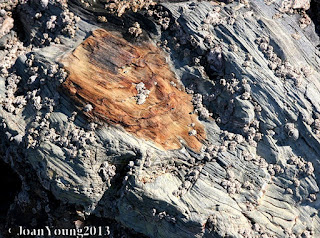Even if you miss everything else, a tour with Benny on the beach at Wild Coast Sun to see, learn about and enjoy the fossils are an absolute must!!
Below: you can judge the size of the ammonite below by the R5 coin which we places on the top left of it. (About the same size as a $1 coin)
The sedimentary rock is rich in fossil remains which can be explored at low tide and ancient remains of huge claims can be seen in the walls of the caves made by wave action dug in the towering cliffs.Below: you can judge the size of the ammonite below by the R5 coin which we places on the top left of it. (About the same size as a $1 coin)
Petrified Forest: Trees become petrified (turned to stone) by having the organic material replaced by minerals (mostly silica and quartz) while retaining the original structure of the tree. The process occurs while the tree is buried under sediment and begins because of the lack of oxygen. It takes at least 100 years for it to completely petrify.
The most wonderful sample is a trunk in the middle of a huge bolder and on one side the age rings of the tree can be seen.
Ammonites: These are related to squid and the ones here are estimated to be at least 85 million years old but have now become extinct. Their preference was for warm, shallow water. Females grew to be much larger than the males and they estimate that the nautilus shells comprising of individual chambers, grew in size as the creature developed. The chambers were secreted at a rate of about 12 per year and ammonites lives for approximately 2 years.
Sharks teeth: Embedded in many of the rocks are sharks teeth which can be seen.
A highlight for me was seeing this petrified turtle perfectly preserved in the cliff wall.
Benny is not only very informative and knowledgeable about the fossils but has an outstanding knowledge of the vegetation, fish and birds etc. of the area which he passes on so everyone can benefit and learn a lot on his guided tour.
He can be contacted directly on +2779 1985 975 or through the Wild Coast Sun Hotel. His tours leave at 9am every morning (Tuesday to Saturday) from the hotel and if fossils have never peaked your interest before, it sure will be after being with him.











2 comments:
So awesome! Definitely going there on the next visit. Always like guides like Benny. And you, of course.
:) Thanks Gaelyn. I am pleased you like my work and company. Benny was super. I gave him copies of all the photographs to use. You will really LOVE it here. Heard about another place with fossile which I am going to check out.
Post a Comment